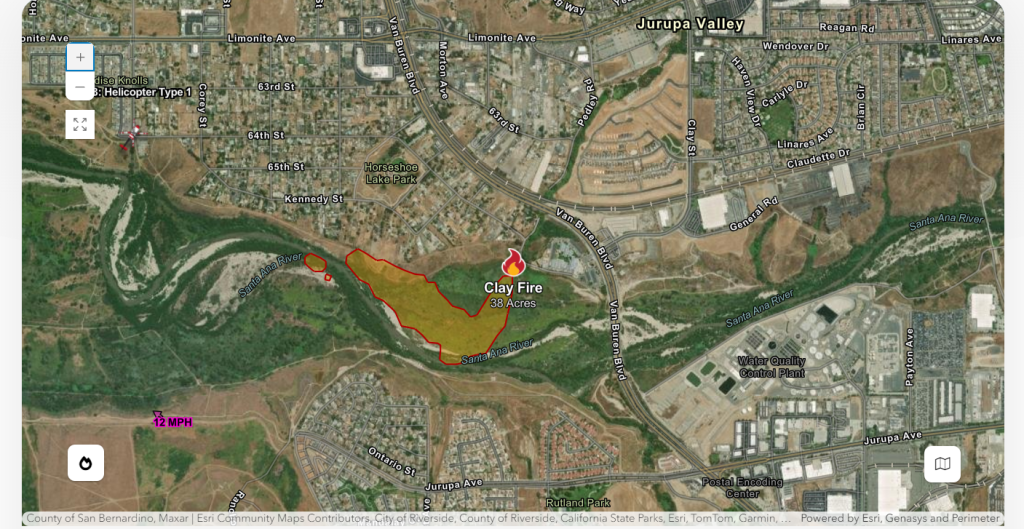The Clay Fire: A Developing Situation in Riverside County
On Tuesday evening, a new wildfire, dubbed the Clay Fire, ignited near Los Angeles in Riverside County, adding to the growing list of blazes that have plagued Southern California throughout January. As of the latest update from the California Department of Forestry and Fire Protection (CAL FIRE) at 6:49 p.m. PT, the fire has consumed approximately 38 acres and remains uncontained. The fire is located near the intersection of Pedley Road and Van Buren Boulevard in Jurupa Valley. The cause of the fire is currently under investigation. This incident unfolds against a backdrop of heightened fire risk and comes on the heels of several other significant wildfires that have ravaged the region in recent weeks.
Southern California’s January Fire Siege
The Clay Fire is not an isolated incident. Southern California has experienced a surge in wildfire activity throughout January, with several fires rapidly escalating into major emergencies. The region’s dry conditions, fueled by an ongoing drought and exacerbated by Santa Ana winds, create a tinderbox-like environment, making the area highly susceptible to wildfires. These conditions allow fires to ignite easily and spread rapidly, posing a significant threat to lives, property, and the environment. The frequency and intensity of these fires underscore the growing challenges posed by climate change and the increasing need for proactive fire prevention and management strategies.
The Palisades and Eaton Fires: Major Incidents with Devastating Impacts
Among the most impactful fires in recent weeks are the Palisades Fire and the Eaton Fire. Both fires grew to substantial sizes, forcing widespread evacuations and resulting in the destruction of thousands of structures. The scale of these fires stretched the resources of firefighting agencies and highlighted the vulnerability of communities located in the wildland-urban interface. The displacement of residents, the loss of homes and businesses, and the long-term recovery efforts pose significant challenges for affected communities. These fires serve as stark reminders of the destructive power of wildfires and the importance of community preparedness.
Air Quality Concerns Amidst Ongoing Fire Suppression Efforts
Beyond the immediate threat to life and property, wildfires also pose a significant risk to public health due to the release of smoke and particulate matter into the atmosphere. As firefighting efforts continue to contain the Clay Fire and other active blazes, air quality has become a growing concern for residents. Smoke from wildfires can travel long distances, impacting air quality in areas far removed from the fire’s origin. Exposure to wildfire smoke can exacerbate respiratory conditions, cause cardiovascular problems, and pose risks to vulnerable populations such as children, the elderly, and individuals with pre-existing health conditions. Monitoring air quality and taking precautions to limit exposure are crucial during active fire events.
The Importance of Preparedness and Community Response
The Clay Fire, along with the other recent wildfires, underscores the critical importance of preparedness and community response in mitigating the impacts of these devastating events. Residents in fire-prone areas should create and maintain defensible space around their homes, develop evacuation plans, and stay informed about fire conditions through official channels. Community-level preparedness initiatives, including early warning systems and coordinated evacuation procedures, are essential for protecting lives and property. Collaboration between residents, local authorities, and firefighting agencies is vital for effective wildfire response and recovery.
Looking Ahead: Addressing the Challenges of Wildfires in Southern California
As Southern California continues to grapple with the increasing threat of wildfires, long-term solutions are needed to address the underlying factors that contribute to these events. Investing in fire prevention measures, such as vegetation management and community education, is crucial. Improving firefighting resources and technologies, including early detection systems and advanced fire suppression equipment, can enhance response capabilities. Addressing climate change and its contribution to drier conditions and increased fire risk requires a comprehensive and collaborative approach. By working together, communities, governments, and researchers can develop sustainable strategies to mitigate the devastating impacts of wildfires and protect the health and well-being of Southern California residents.

